Hi,
Want to learn about the hodo Japanese grammar rule?
Saying you just did something. Well, there are a few uses that you’ll pick up here. “Hodo” is used for…
- To give approximations
- To compare to prior expectations/thoughts
- To express that “X” is not as much as “Y”
- To show that something can be so “adjective” that anyone can do it.
- To express that “X” is so ___, that you can’t Y.”
Now that you have a quick idea of how the hodo Japanese grammar is used… and have general impression, let’s get into the specifics.
Here are the 5 types of rules for hodo grammar usage.
 | Want FREE Japanese Grammar & Vocab Cheat Sheets? Click Here to Get 20+ Cheat Sheets from JapanesePod101 (a Japanese learning program.) |
Rule #1 Counter + hodo — About or Approximately
“It took Linguajunkie (that’s me) about 1 hour “hodo” to write this article.”
Hodo can be used as a way to indicate “about” or “approximately. When used like this, you need to have a counter word before hodo that shows quantities like cost, distance, or weight. It can be useful if you’re at the grocery store and want to ask for an approximate amount of an ingredient or to express a length of time.
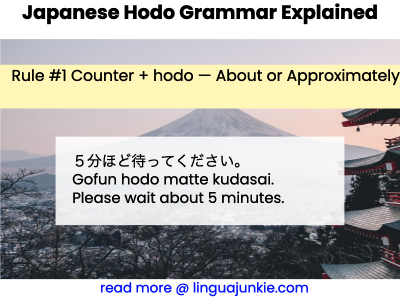
This rule is fairly similar to the bakari japanase grammar rule.
- 20キロほど先にガソリンスタンドがあります。
- Nijukkiro hodo saki ni gasorin sutando ga arimasu.
- There is a gas station about 20 kilometers away.
- 牛肉を300グラムほどください。
- Gyuuniku o sanbyaku guramu hodo kudasai.
- I’d like to have about 300 grams of beef.
- 1時間ほどで終わります。
- Ichijikan hodo de owarimasu.
- It will be done in about 1 hour.
- 5分ほど待ってください。
- Gofun hodo matte kudasai.
- Please wait about 5 minutes.
- 豆を1キロほどください。
- Mame o ichi kiro hodo kudasai.
- Please give me about 1 kilogram of beans.
Rule #2 Past tense verb + hodo — Comparing to past expectations/thoughts
“Learning this hodo Japanese grammar rule isn’t as hard as you’d thought.”
This grammar rule uses hodo as a way to compare how you felt about something before and how you feel now. Although it could be grammatically correct to use any past tense verb, you’ll want to stick to verbs that express feelings. These can include verbs like 思う (omou) “to think”, 心配する (shinpai suru) “to worry”, or 想像する (souzou suru) “to imagine”. In order to form these sentences, you simply need to take the past tense form and add hodo to the end.
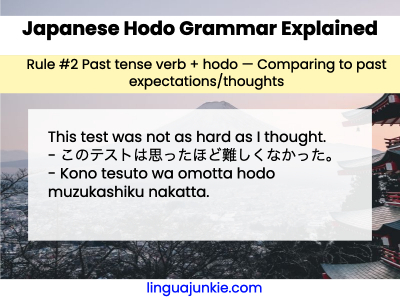
- このテストは思ったほど難しくなかった。
- Kono tesuto wa omotta hodo muzukashiku nakatta.
- This test was not as hard as I thought.
- 面接は心配したほど大変じゃなかった。
- Mensetsu wa shinpai shitahodo kowaku nakatta.
- The interview was not as scary as I had worried about.
- 思ったほど時間がかからなかった。
- Omotta hodo jikan ga kakara nakatta.
- It didn’t take as long as I had thought.
- あの海は想像したほど綺麗じゃなかった。
- Ano umi wa souzou shita hodo kirei janakatta.
- That ocean was not as beautiful as I had imagined.
- この高級レストランは想像したほど美味しくなかった。
- Kono koukyuu resutoran wa souzou shita hodo oishiku nakatta.
- This high-end restaurant was not as delicious as I imagined.
Rule #3 Noun + hodo + negative phrase — “Noun X is Not As Much as Y”
“Other people are not as smart as Linguajunkie blog readers.”
When you put a noun before hodo followed by a negative phrase, you can easily make comparisons. This is useful when you want to express your opinions on things that you believe are better or have special qualities. These phrases can be a bit confusing for English speakers because you need to form a negative phrase even if the overall statement is positive.
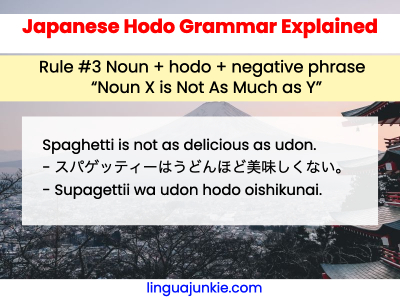
- 猫は犬ほど人間に興味がない。
- Neko wa inu hodo ningen ni kyoumi ga nai.
- Cats don’t have as much interest in people as dogs.
- 彼ほどサッカーが上手な人はいない。
- Kare hodo sakkaa ga jouzu na hito wa inai.
- There is no one as good at soccer as him.
- バレーボールは野球ほど楽しくない。
- Bareebooru wa yakyuu hodo tanoshiku nai.
- Volleyball is not as fun as baseball.
- アメリカの料理は日本食ほど歴史が深くない。
- Amerika no ryouri wa nihonshoku hodo rekishi ga fukaku nai.
- American cuisine doesn’t have as deep of a history as Japanese cuisine.
- スパゲッティーはうどんほど美味しくない。
- Supagettii wa udon hodo oishikun nai.
- Spaghetti is not as delicious as udon.
Rule #4 Dictionary form verb/adjective + hodo
“This “Hodo” grammar rule is so easy that anyone can learn it.”
Dictionary form verbs and adjectives can also pair up with hodo. When a dictionary form of a verb sticks to hodo, it makes the hodo act like the word “that”. Dictionary form adjectives on the other hand, tend to show a correlation between two adjectives when used with hodo. In general, this form of using hodo is the most difficult to master because it doesn’t translate to English in a predictable way.
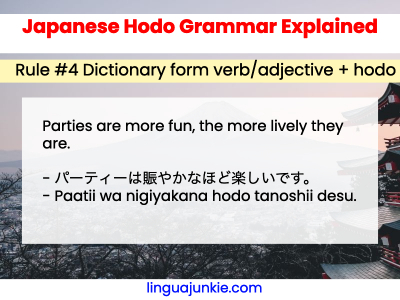
- この山道は初心者でも歩けるほど簡単です。
- Kono yama michi wa shoshinsha de mo arukeru hodo kantan desu.
- This mountain path is so easy that even beginners can walk it.
- 日本で通じるほど日本語が上達しました。
- Nihon de tsuujiru hodo nihongo ga joutatsu shimashita.
- My Japanese has improved so much that I can communicate in Japan.
- パーティーは賑やかなほど楽しいです。
- Paatii wa nigiyakana hodo tanoshii desu.
- Parties are more fun, the more lively they are.
- 内容が面白いほど勉強が進みます。
- Naiyou ga omoshiroi hodo benkyou ga susumimasu.
- The more interesting the topic, the faster my studying progresses.
- 大人でも楽しめるほど素晴らしい映画です。
- Otona demo tanoshimeru hodo subarashii eiga desu.
- The movie is so amazing that even adults can enjoy it.
Rule #5 Nai form verb + hodo — So X, that I can’t Y
“Linguajunkie is so nice and helpful that I can’t believe it.”
If you put the nai form verb with hodo you can form sentences that connect phrases. The first phrase tends to express why the second phrase happens. For example, “I’m so tired that I can’t continue”, would be 続けられないほど疲れた。(tsuzukerarenai hodo tsukareta). In this sentence, the reason you can’t continue is because you are tired. As you can see, nai form + hodo can connect two phrases.
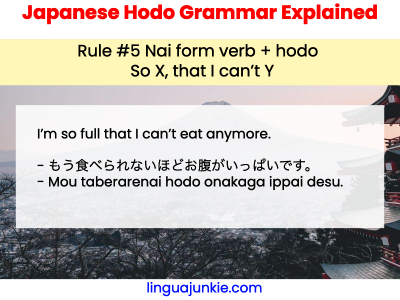
- もう食べられないほどお腹がいっぱいです。
- Mou taberarenai hodo onakaga ippai desu.
- I’m so full that I can’t eat anymore.
- 信じられないほど美しい絵です。
- Shinjirarenai hodo utsukushii e desu.
- This painting is so beautiful that I can’t believe it.
- 想像できないほど大きな地震でした。
- Souzou dekinai hodo ookina jishin deshita.
- The earthquake was so big that I couldn’t even imagine it.
- 起き上がれないほど体力を使いました。
- Okiagarenai hodo tairyoku o tsukai mashita.
- I used so much energy that I can’t even get up.
- メールが打てないほど忙しかったです。
- Meeru ga utenai hodo isogashikatta desu.
- I was so busy that I couldn’t send a text message.
Conclusion – Back to You.
Now, I hope you have a decent idea of how this grammar rule is used.
- To give approximations
- To compare to prior expectations/thoughts
- To express that “X” is not as much as “Y”
- To show that something can be so “adjective” that anyone can do it.
- To express that “X” is so ___, that you can’t Y.”
If you want to practice, leave a comment.
Or, read through the rules some more.
If you want to save this page, go ahead and print it out.
Either way, thanks for reading and for learning Japanese with Linguajunkie.
– The Main Lingua Junkie
 | Want FREE Japanese Grammar & Vocab Cheat Sheets? Click Here to Get 20+ Cheat Sheets from JapanesePod101 (a Japanese learning program.) |